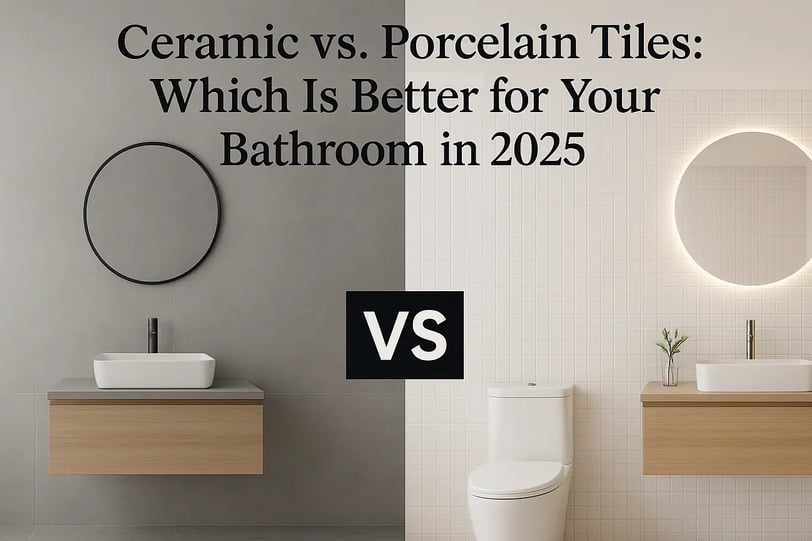Ceramic tiles vs Porcelain Tiles: Best Bathroom Options 2025
Confused between ceramic tiles and porcelain tiles? Discover the best bathroom tiles for 2025 that fit your style, budget, and needs. Make an informed choice for your home renovation.
TILE DESIGN-TRENDS
Asil atique
5/15/20253 min read


Ceramic vs Porcelain Tiles: What's Better for Your Bathroom?
When you're constructing or remodeling a new bathroom, the largest decision you'll make is the tile. And of the fashionable options? Ceramic tiles and porcelain tiles. Though they might look like twins at first glance, these two are very different when it comes to durability, water resistance, cost, and lifespan. So what do you do?
In this blog post, we will dispel the myths regarding the advantages and disadvantages of ceramic and porcelain tiles and assist you in choosing the perfect tile for your bathroom.
1. What are the key differences between Ceramic and Porcelain tiles?
Though ceramic and porcelain tiles are both manufactured from natural clay, they have different production processes that yield different characteristics.
Red or white clay, which is fired at comparatively low temperatures, constitutes Ceramic Tiles. They are more porous and softer.
Porcelain tiles consist of high-quality clay and are also fired at high temperatures, typically between 1,200°C to 1,400°C (2,192°F to 2,552°F), resulting in a dense, hard, and low-porosity product.
On the other hand, ceramic tiles are made from less refined clay and lower firing temperatures, about 1,000°C to 1,200°C (1,832°F to 2,192°F), and hence are more porous and less dense.
This difference in composition provides porcelain tiles with a highly desirable advantage when it comes to durability and water resistance.
2. Lifespan and Durability
Porcelain tiles are durable. They are wear and tear-resistant and long-lasting, hence ideal for a busy home with kids and pets or a busy bathroom. Because they are denser, they also have less chance of cracking under pressure.
Ceramic tiles, though still extremely hard, are best suited for low traffic through to moderate traffic. They are more prone to crack and don't hold impact as well as porcelain.
Porcelain Award for Endurance
3. Water Resistance and Moisture Handling
In damp places such as bathrooms, moisture resistance is needed.
Porcelain also has a water absorption rate of less than 0.5%, making it very water-resistant. It is wonderful to install on bathroom walls and floors, even for steam rooms.
Ceramic retains more, therefore contains more water, and must be well sealed if employed in very wet conditions.
Porcelain - Award for Water Resistance
4. Style, Design, and Versatility
Porcelain tiles are offered in a vast array of styles, colors, and finishes because of digital printing technology. Porcelain tiles are able to replicate the look of natural materials like wood and stone, the visual attractiveness of these materials, and the durability and low maintenance of porcelain.
From hardwood look planks that replicate the grain and texture of hardwood through to stone look tiles that replicate the veining of marble or the hard look of slate, porcelain tiles have design solutions for every space. They are wear, stain, and moisture resistant and therefore ideal for domestic and commercial use, high traffic environments, and wet environments.
With the use of porcelain tiles imitating natural materials, refined and functional interiors are achieved, with enduring design with modern performance.
Ceramic tile is easier to cut and thus more convenient to work with for application to decorative wall patterns or backsplashes. They will be more likely to be colorful and innovative in design.
Winner for Easy Customization: Ceramic,
Winner in High-End Appearance: Porcelain
5. Cost Comparison
Budget will most often be the deciding factor:
Ceramic tiles are easy on the pocket. As they are not costly, they are the best option for affordable bathroom renovations.
Porcelain tiles are more expensive to install initially, but their increased durability and cleanliness tend to make them an economical option in the long term. They are ideally suited for high-traffic and damp spaces such as bathrooms and kitchens.
Winner for the Budget-Friendly Option: Ceramic
6. Installation and Maintenance
The ceramic tiles are simpler to cut and weigh less, so the job is faster and overall less expensive. They are perfect for the do-it-yourself handyman.
Porcelain tiles are harder and more resistant, and have to be professionally installed and need specialist equipment.
Both are low-maintenance in the context that both can be swept and mopped on a frequent basis. Porcelain, however, requires less sealing.
Winner for DIY Installation: Ceramic
Winner in Low Maintenance: Porcelain
CONCLUSION
Which Tile is better to use for the bathroom?
Choose Porcelain Tiles if you want durability, water-resistance, and a glossy, high-end finish that will last you for many years. Opt for Ceramic Tiles when you have a tight budget, such as today's trends, and will be doing the installation yourself. Both porcelain and ceramic tiles provide excellent opportunities for designing a stunning and long-lasting bathroom. Porcelain tiles are famously known for their strength and low water absorption, and they are perfect for wet areas. Ceramic tiles, although slightly porous, are inexpensive and come in an incredibly wide variety of designs. The choice between them is based on your needs, your budget, and your tastes. Your decision relies on your budget, your tastes, and the traffic your bathroom will receive. Ready to tile your way to a fantastic bathroom?
